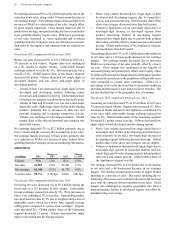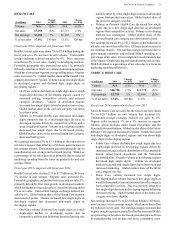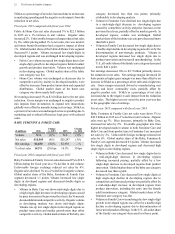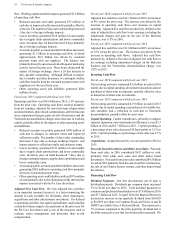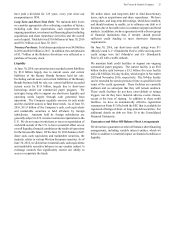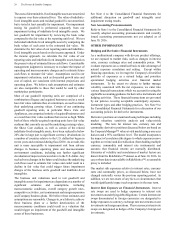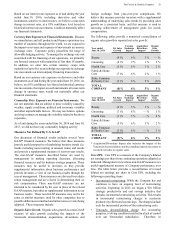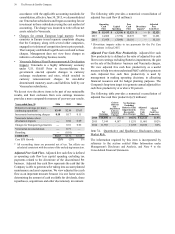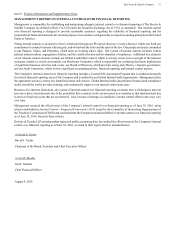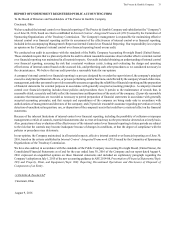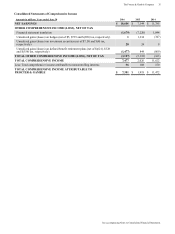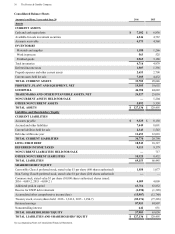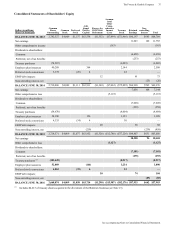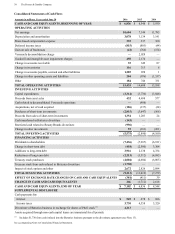Proctor and Gamble 2016 Annual Report Download - page 42
Download and view the complete annual report
Please find page 42 of the 2016 Proctor and Gamble annual report below. You can navigate through the pages in the report by either clicking on the pages listed below, or by using the keyword search tool below to find specific information within the annual report.28 The Procter & Gamble Company
The costs of determinable-lived intangible assets are amortized
to expense over their estimated lives. The value of indefinite-
lived intangible assets and residual goodwill is not amortized,
but is tested at least annually for impairment. Our impairment
testing for goodwill is performed separately from our
impairment testing of indefinite-lived intangible assets. We
test goodwill for impairment by reviewing the book value
compared to the fair value at the reporting unit level. We test
individual indefinite-lived intangible assets by comparing the
book values of each asset to the estimated fair value. We
determine the fair value of our reporting units and indefinite-
lived intangible assets based on the income approach. Under
the income approach, we calculate the fair value of our
reporting units and indefinite-lived intangible assets based on
the present value of estimated future cash flows. Considerable
management judgment is necessary to evaluate the impact of
operating and macroeconomic changes and to estimate future
cash flows to measure fair value. Assumptions used in our
impairment evaluations, such as forecasted growth rates and
cost of capital, are consistent with internal projections and
operating plans. We believe such assumptions and estimates
are also comparable to those that would be used by other
marketplace participants.
Most of our goodwill reporting units are comprised of a
combination of legacy and acquired businesses and as a result
have fair value cushions that, at a minimum, exceed two times
their underlying carrying values. Certain of our continuing
goodwill reporting units, in particular Shave Care and
Appliances, are comprised entirely of acquired businesses and
as a result have fair value cushions that are not as high. While
both of these wholly-acquired reporting units have fair value
cushions that currently exceed the underlying carrying values,
the Shave Care cushion, as well as certain of the related
indefinite-lived intangible assets, have been reduced to below
20% due in large part to significant currency devaluations in
a number of countries relative to the U.S. dollar that began in
recent years and continued during fiscal 2016. As a result, this
unit is more susceptible to impairment risk from adverse
changes in business operating plans and macroeconomic
environment conditions, including any further significant
devaluation of major currencies relative to the U.S. dollar. Any
such adverse changes in the future could reduce the underlying
cash flows used to estimate fair values and could result in a
decline in fair value that could trigger future impairment
charges of the business unit's goodwill and indefinite-lived
intangibles.
The business unit valuations used to test goodwill and
intangible assets for impairment are dependent on a number of
significant estimates and assumptions, including
macroeconomic conditions, overall category growth rates,
competitive activities, cost containment and margin expansion
and Company business plans. We believe these estimates and
assumptions are reasonable. Changes to, or a failure to, achieve
these business plans or a further deterioration of the
macroeconomic conditions could result in a valuation that
would trigger an impairment of the goodwill and intangible
assets of these businesses.
See Note 4 to the Consolidated Financial Statements for
additional discussion on goodwill and intangible asset
impairment testing results.
New Accounting Pronouncements
Refer to Note 1 to the Consolidated Financial Statements for
recently adopted accounting pronouncements and recently
issued accounting pronouncements not yet adopted as of
June 30, 2016.
OTHER INFORMATION
Hedging and Derivative Financial Instruments
As a multinational company with diverse product offerings,
we are exposed to market risks, such as changes in interest
rates, currency exchange rates and commodity prices. We
evaluate exposures on a centralized basis to take advantage of
natural exposure correlation and netting. Except within
financing operations, we leverage the Company's diversified
portfolio of exposures as a natural hedge and prioritize
operational hedging activities over financial market
instruments. To the extent we choose to further manage
volatility associated with the net exposures, we enter into
various financial transactions which we account for using the
applicable accounting guidance for derivative instruments and
hedging activities. These financial transactions are governed
by our policies covering acceptable counterparty exposure,
instrument types and other hedging practices. See Note 9 to
the Consolidated Financial Statements for a discussion of our
accounting policies for derivative instruments.
Derivative positions are monitored using techniques including
market valuation, sensitivity analysis and value-at-risk
modeling. The tests for interest rate, currency rate and
commodity derivative positions discussed below are based on
the CorporateManager™ value-at-risk model using a one-year
horizon and a 95% confidence level. The model incorporates
the impact of correlation (the degree to which exposures move
together over time) and diversification (from holding multiple
currency, commodity and interest rate instruments) and
assumes that financial returns are normally distributed.
Estimates of volatility and correlations of market factors are
drawn from the RiskMetrics™ dataset as of June 30, 2016. In
cases where data is unavailable in RiskMetrics™, a reasonable
proxy is included.
Our market risk exposures relative to interest rates, currency
rates and commodity prices, as discussed below, have not
changed materially versus the previous reporting period. In
addition, we are not aware of any facts or circumstances that
would significantly impact such exposures in the near term.
Interest Rate Exposure on Financial Instruments. Interest
rate swaps are used to hedge exposures to interest rate
movement on underlying debt obligations. Certain interest rate
swaps denominated in foreign currencies are designated to
hedge exposures to currency exchange rate movements on our
investments in foreign operations. These currency interest rate
swaps are designated as hedges of the Company's foreign net
investments.




